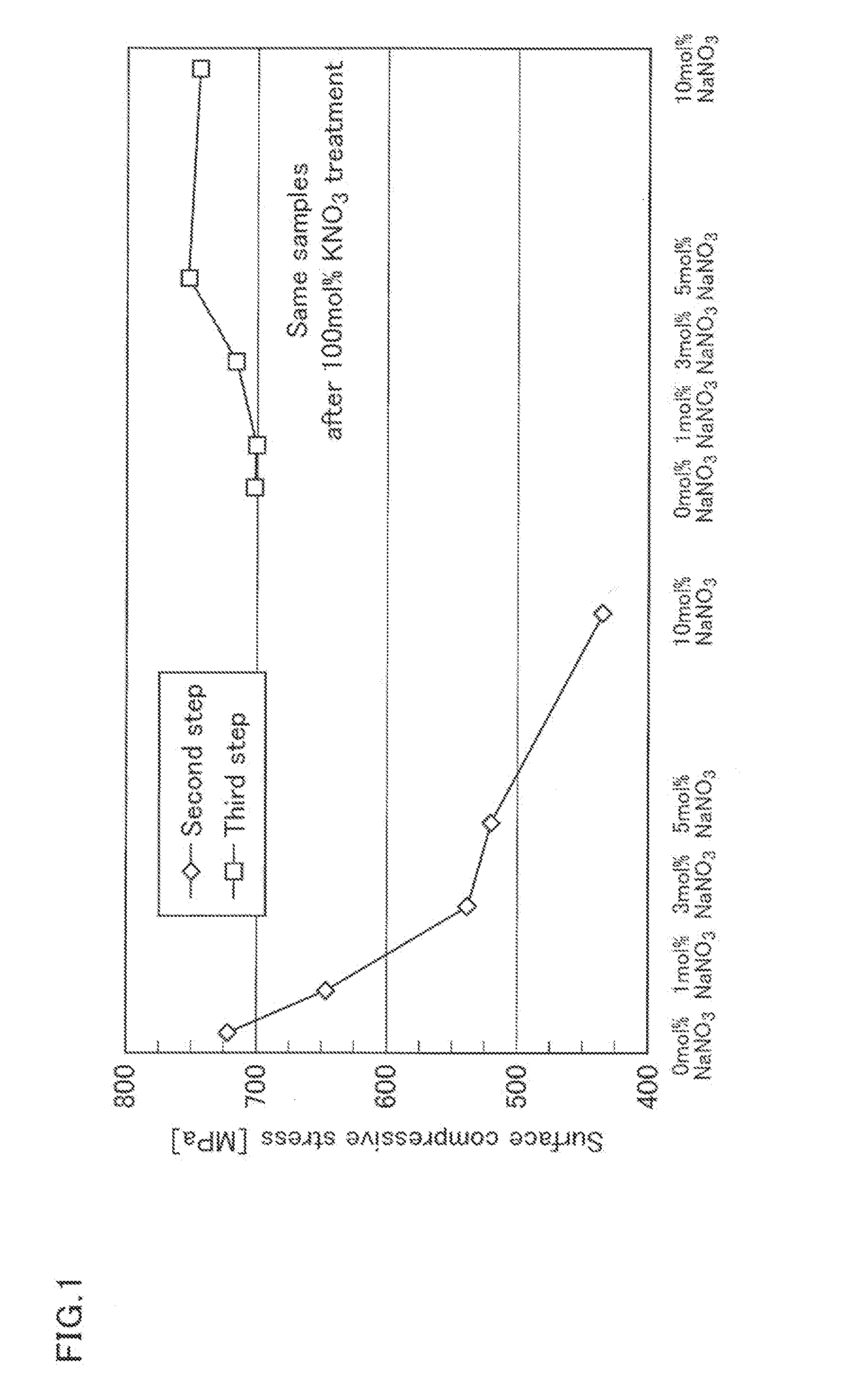Method of manufacturing chemically strengthened glass plate
a technology of chemical strengthening and glass plate, applied in the field of manufacturing a chemically strengthened glass plate, can solve the problems of less likely to provide a compressive stress layer at the glass plate surface, higher probability of cracking, and less susceptible to cracking, and achieve the effect of high surface compressive stress
- Summary
- Abstract
- Description
- Claims
- Application Information
AI Technical Summary
Benefits of technology
Problems solved by technology
Method used
Image
Examples
example 1
[0117]A glass plate not subjected to ion exchange (chemical strengthening), specifically, a 1.1-mm thick soda-lime glass (SiO2: 71.3%, Na2O: 13.0%, K2O: 0.85%, CaO: 9.01, MgO: 3.6%, Al2O3: 2.0%, Fe2O3: 0.15%, SO3: 0.1% (on a mass basis)) produced by a float process was prepared, and about 80-mm diameter disc substrates (hereinafter, referred to as glass base plates) were prepared therefrom.
[0118]In the first step, a glass base plate prepared above was submerged in a molten salt bath substantially composed of 100 mol % sodium nitrate (NaNO3) (first salt, ratio X: 100 mol %) at a constant temperature of 475° C. for two hours.
[0119]Subsequently, the glass base plate was taken out from the bath, and its surface was washed and dried.
[0120]The glass base plate was measured for the composition with X-ray fluorescence before and after the first step. The results revealed that the proportional amount of sodium in a surface layer after the first step was increased by about 1% by mass from the...
example 2
[0130]A mixture molten salt containing 99 mol % potassium nitrate and 1 mol % sodium nitrate (ratio Y: 1 mol %) was prepared as the second salt used in the second step.
[0131]A chemically strengthened glass plate was produced in the same manner as in Example 1, except that the above-mentioned second salt was used in the second step.
[0132]The surface compressive stress and the depth of the compressive stress layer of the glass sample after the second step were 646 MPa and 10 μm, respectively. The surface compressive stress and the depth of the compressive stress layer of the glass sample after the third step (the chemically strengthened glass plate of Example 2) were 700 MPa and 12 μm, respectively.
example 3
[0133]A mixture molten salt containing 97 mol % potassium nitrate and 3 mol % sodium nitrate (ratio Y: 3 mol %) was prepared as the second salt for the second step.
[0134]A chemically strengthened glass plate was produced in the same manner as in Example 1, except that the above-mentioned second salt was used in the second step.
[0135]The surface compressive stress and the depth of the compressive stress layer of the glass sample after the second step were 538 MPa and 10 μm, respectively. The surface compressive stress and the depth of the compressive stress layer of the glass sample after the third step (the chemically strengthened glass plate of Example 3) were 716 MPa and 12 μm, respectively.
PUM
| Property | Measurement | Unit |
|---|---|---|
| surface compressive stress | aaaaa | aaaaa |
| depth | aaaaa | aaaaa |
| thickness | aaaaa | aaaaa |
Abstract
Description
Claims
Application Information
 Login to View More
Login to View More - R&D
- Intellectual Property
- Life Sciences
- Materials
- Tech Scout
- Unparalleled Data Quality
- Higher Quality Content
- 60% Fewer Hallucinations
Browse by: Latest US Patents, China's latest patents, Technical Efficacy Thesaurus, Application Domain, Technology Topic, Popular Technical Reports.
© 2025 PatSnap. All rights reserved.Legal|Privacy policy|Modern Slavery Act Transparency Statement|Sitemap|About US| Contact US: help@patsnap.com

